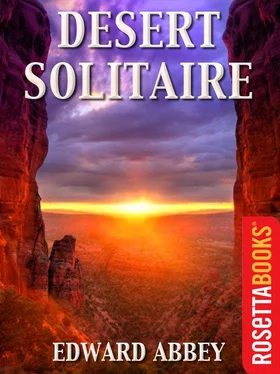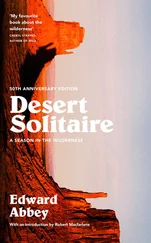Abbey, Edward - Desert Solitaire (Edward Abbey Series )
Здесь есть возможность читать онлайн «Abbey, Edward - Desert Solitaire (Edward Abbey Series )» — ознакомительный отрывок электронной книги совершенно бесплатно, а после прочтения отрывка купить полную версию. В некоторых случаях можно слушать аудио, скачать через торрент в формате fb2 и присутствует краткое содержание. Год выпуска: 2011, Издательство: RosettaBooks, Жанр: Старинная литература, на английском языке. Описание произведения, (предисловие) а так же отзывы посетителей доступны на портале библиотеки ЛибКат.
- Название:Desert Solitaire (Edward Abbey Series )
- Автор:
- Издательство:RosettaBooks
- Жанр:
- Год:2011
- ISBN:нет данных
- Рейтинг книги:4 / 5. Голосов: 1
-
Избранное:Добавить в избранное
- Отзывы:
-
Ваша оценка:
- 80
- 1
- 2
- 3
- 4
- 5
Desert Solitaire (Edward Abbey Series ): краткое содержание, описание и аннотация
Предлагаем к чтению аннотацию, описание, краткое содержание или предисловие (зависит от того, что написал сам автор книги «Desert Solitaire (Edward Abbey Series )»). Если вы не нашли необходимую информацию о книге — напишите в комментариях, мы постараемся отыскать её.
Desert Solitaire (Edward Abbey Series ) — читать онлайн ознакомительный отрывок
Ниже представлен текст книги, разбитый по страницам. Система сохранения места последней прочитанной страницы, позволяет с удобством читать онлайн бесплатно книгу «Desert Solitaire (Edward Abbey Series )», без необходимости каждый раз заново искать на чём Вы остановились. Поставьте закладку, и сможете в любой момент перейти на страницу, на которой закончили чтение.
Интервал:
Закладка:
I get up and start back to the trailer. A smell of burning coffee on the wind. On the way I pass a large anthill, the domed city of the harvester ants. Omnivorous red devils with a vicious bite, they have denuded the ground surrounding their hill, destroying everything green and living within a radius of ten feet. I cannot resist the impulse to shove my walking stick into the bowels of their hive and rowel things up. Don’t actually care for ants. Neurotic little pismires. Compared to ants the hairy scorpion is a beast of charm, dignity and tenderness.
My favorite juniper stands before me glittering shaggily in the sunrise, ragged roots clutching at the rock on which it feeds, rough dark boughs bedecked with a rash, with a shower of turquoise-colored berries. A female, this ancient grandmother of a tree may be three hundred years old; growing very slowly, the juniper seldom attains a height greater than fifteen or twenty feet even in favorable locations. My juniper, though still fruitful and full of vigor, is at the same time partly dead: one half of the divided trunk holds skyward a sapless claw, a branch without leaf or bark, baked by the sun and scoured by the wind to a silver finish, where magpies and ravens like to roost when I am not too close.
I’ve had this tree under surveillance ever since my arrival at Arches, hoping to learn something from it, to discover the significance in its form, to make a connection through its life with whatever falls beyond. Have failed. The essence of the juniper continues to elude me unless, as I presently suspect, its surface is also the essence. Two living things on the same earth, respiring in a common medium, we contact one another but without direct communication. Intuition, sympathy, empathy, all fail to guide me into the heart of this being—if it has a heart.
At times I am exasperated by the juniper’s static pose; something in its stylized gesture of appeal, that dead claw against the sky, suggests catalepsy. Perhaps the tree is mad. The dull, painful creaking of the branches in the wind indicates, however, an internal effort at liberation.
The wind flows around us from the yellow haze in the east, a morning wind, a solar wind. We’re in for a storm today, dust and sand and filthy air.
Without flowers as yet but bright and fresh, with leaves of a startling, living green in contrast to the usual desert olive drab, is a shrub known as singleleaf ash, one of the few true deciduous plants in the pinyon-juniper community. Most desert plants have only rudimentary leaves, or no leaves at all, the better to conserve moisture, and the singleleaf ash seems out of place here, anomalous, foredoomed to wither and die. ( Fraxinus anomala is the botanical name.) But touch the leaves of this plant and you find them dry as paper, leathery in texture and therefore desert-resistant. The singleleaf ash in my garden stands alone along the path, a dwarf tree only three feet high but tough and enduring, clenched to the stone.
Sand sage or old man sage, a lustrous windblown blend of silver and blue and aquamarine, gleams in the distance, the feathery stems flowing like hair. Purple flowers no bigger than your fingernail are half-revealed, half-concealed by the shining leaves. Purple sage: crush the leaves between thumb and finger and you release that characteristic odor, pungent and bittersweet, which means canyon country, high lonesome mesaland, the winds that blow from far away.
Also worthy of praise is the local pinyon pine, growing hereabouts at isolated points, for its edible nuts that appear in good years, for its ragged raunchy piney good looks, for the superior qualities of its wood as fuel—burns clean and slow, little soot, little ash, and smells almost as good as juniper. Unfortunately, most of the pinyon pines in the area are dead or dying, victims of another kind of pine—the porcupine. This situation came about through the conscientious efforts of a federal agency known formerly as the Wildlife Service, which keeps its people busy in trapping, shooting and poisoning wildlife, particularly coyotes and mountain lions. Having nearly exterminated their natural enemies, the wildlife experts made it possible for the porcupines to multiply so fast and so far that they—the porcupines—have taken to gnawing the bark from pinyon pines in order to survive.
What else? Still within sight of the housetrailer, I can see the princess plume with its tall golden racemes; the green ephedra or Mormon tea, from which Indians and pioneers extracted a medicinal drink (contains ephedrine), the obnoxious Russian thistle, better known as tumbleweed, an exotic; pepperweed, bladderweed, snakeweed, matchweed, skeleton weed—the last-named so delicately formed as to be almost invisible; the scrubby little wavyleaf oak, stabilizer of sand dunes; the Apache plume, poor cousin of the cliffrose; gray blackbrush, most ubiquitous and humble of desert plants, which will grow where all else has given up; more annuals—primrose, sourdock, yellow and purple beeplant, rockcress, wild buckwheat, grama grass, and five miles north across the floor of Salt Valley, acres and acres of the coral-colored globemallow.
Not quite within eyeshot but close by, in a shady dampish secret place, the sacred datura—moonflower, moonlily, thornapple—blooms in the night, soft white trumpet-shaped flowers that open only in darkness and close with the coming of the heat. The datura is sacred (to certain cultists) because of its content of atropine, a powerful narcotic of the alkaloid group capable of inducing visionary hallucinations, as the Indians discovered long before the psychedelic craze began. How they could have made such a discovery without poisoning themselves to death nobody knows; but then nobody knows how so-called primitive man made his many other discoveries. We must concede that science is nothing new, that research, empirical logic, the courage to experiment are as old as humanity.
Most of the plants I have named so far belong to what ecologists call the pinyon pine-juniper community, typical of the high, dry, sandy soils of the tablelands. Descend to the alkali flats of Salt Valley and you find an entirely different grouping: shadscale, four-winged saltbush, greasewood, spiny horsebrush, asters, milk vetch, budsage, galletagrass. Along the washes and the rare perennial streams you’ll find a third community: the Fremont poplar or Cottonwood tree, willow, tamarisk, rabbitbrush or chamisa , and a variety of sedges, tules, rushes, reeds, cattails. The fourth plant community, in the Arches area, is found by the springs and around the seeps on the canyon walls—the hanging gardens of fern, monkeyflower, death camas, columbine, helleborine orchid, bracken, panicgrass, bluestem, poison ivy, squawbush, and the endemic primrose Primula specuiola , found nowhere but in the canyonlands.
So much for the inventory. After such a lengthy listing of plant life the reader may now be visualizing Arches National Monument as more a jungle than a desert. Be reassured, it is not so. I have called it a garden, and it is—a rock garden. Despite the great variety of living things to be found here, most of the surface of the land, at least three-quarters of it, is sand or sandstone, naked, monolithic, austere and unadorned as the sculpture of the moon. It is undoubtedly a desert place, clean, pure, totally useless, quite unprofitable.
The sun is rising through a yellow, howling wind. Time for breakfast. Inside the trailer now, broiling bacon and frying eggs with good appetite, I hear the sand patter like rain against the metal walls and brush across the windowpanes. A fine silt accumulates beneath the door and on the window ledge. The trailer shakes in a sudden gust. All one to me—sandstorm or sunshine I am content, so long as I have something to eat, good health, the earth to take my stand on, and light behind the eyes to see by.
Читать дальшеИнтервал:
Закладка:
Похожие книги на «Desert Solitaire (Edward Abbey Series )»
Представляем Вашему вниманию похожие книги на «Desert Solitaire (Edward Abbey Series )» списком для выбора. Мы отобрали схожую по названию и смыслу литературу в надежде предоставить читателям больше вариантов отыскать новые, интересные, ещё непрочитанные произведения.
Обсуждение, отзывы о книге «Desert Solitaire (Edward Abbey Series )» и просто собственные мнения читателей. Оставьте ваши комментарии, напишите, что Вы думаете о произведении, его смысле или главных героях. Укажите что конкретно понравилось, а что нет, и почему Вы так считаете.












